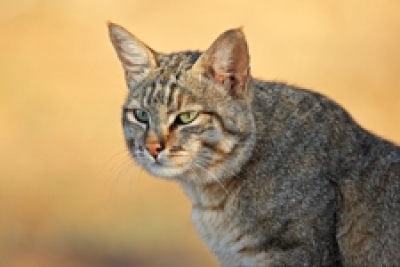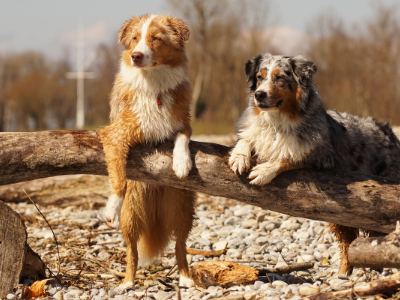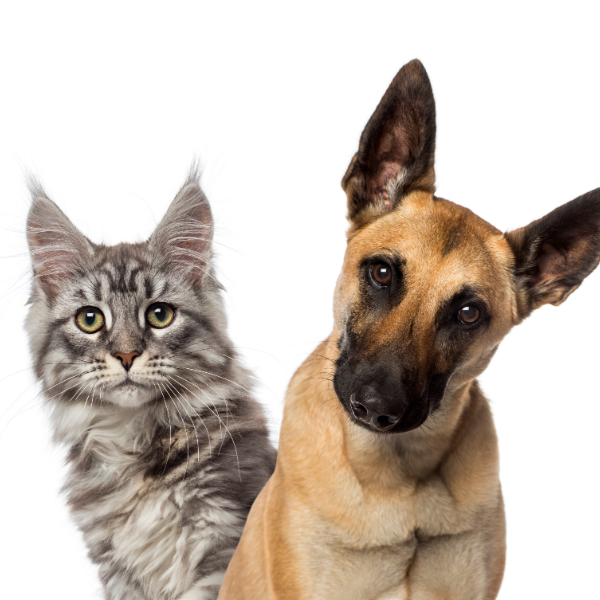Cats are classified as obligate carnivores, meaning that they cannot survive as scavengers or vegetarians. They must eat meat. Studying the cat’s wild counterparts helps us to understand the dietary requirements of the species. The African wild cat will hunt small prey daily and must feed regularly. Their bodies and minds tell the story of a carnivore.
ANATOMY
Wild and domestic cats share the same anatomical features. These characteristics are used by scientists to classify an animal as herbivore, omnivore, or carnivore. Felines are classified as part of the Order Carnivora. Below, the carnivorous traits of the cat are discussed.
Cats have an extraordinary diurnal and nocturnal vision, allowing them to see prey in the dark and sneak up on them with great stealth. The cat has long, muscular back legs, making them adept at pouncing on prey in ambush attacks. They have the ability to move their ears</strong> independently so that sound bounces back at different frequencies, telling them how near or far away their prey might be. The cat also possesses long whiskers</strong> that pick up minute vibrations prey create when walking. This allows them to tell where prey is before they catch sight of it. Lastly, cats have sharp, retractable claws</strong> in their toes, used for grabbing and holding prey.
PHRENOLOGY


The skull of an animal tells the story of its evolution. Prehistoric cats roamed the earth millions of years before the first man appeared. The physical structures of the animal have undergone hundreds of changes over time to best help them survive as predators.
Below, a cat skull and the skull of a deer (herbivore). Upon examination of the skull photos, we can see that certain features are pronounced in each case. We can also see the similarities between the domestic cat and the African wild cat skull. Focusing on the skull of the cat, the eye sockets face forward as do all predators so that they may look directly at prey while stalking. Herbivore eyes are situated on the sides on the sides of the head to maximize the range of vision while their heads are down and the animal is grazing. This range of vision helps them to see predators from as many different angles as possible.
Predominant canine teeth, pre-molars shaped for cutting, and sectoral (shearing) teeth are tell-tale features of a carnivore. The jaw moves in a vertical fashion and does not move from side to side. Herbivores have developed special hinges in the jaw that allow for this horizontal movement so that they may grind grasses, roots, branches before swallowing. Carnivores swallow their food virtually whole. They have only developed lateral jaw movement because it suites their predatory lifestyle. In addition, the angels of the snout, jaw, and zygomatic arch (found behind the maxilla) have developed to maximize bite power. Carnivores have some of the highest bite power ratios in the animal kingdom. After millions of years specializing as meat-eaters, the cat’s anatomy evolved to ensure the highest possible survival rate.
PHYSIOLOGY
Physiologically, the cat is unique in several ways. An animal-based, high protein diet is necessary for maintaining long-term health. Feline liver enzymes used to break down proteins are always active where they are not in other mammalian species. The cat uses part of its protein intake just to fuel this ongoing process. It cannot be deactivated if a cat is fed a low protein diet.
Compared to omnivores and herbivores, carnivores have short, highly acidic digestive tracts. The intestine and the bowel of a carnivore are much shorter than a human’s, allowing for quick absorption and elimination of waste products. Along with powerful acidity in the gut, the short length of the intestine protects against bacterial contamination of meat. A short and acidic gut is naturally anti-bacterial and ensures that meat cannot become contaminated with bacteria.
The pancreas of the cat is meant to supplement the enzymes ingested with the diet. In the wild, cats obtain a large amount of the enzymes they require from dietary sources. Food must come complete with the active enzymes that bind and break down nutrients for absorption, otherwise, the pancreas is called on to produce all of the required enzymes. Enzymes are the precursors for many metabolic processes in the mammalian body. They are an essential part of any diet. Cooked food is not well utilized by the feline species. It contains only denatured enzymes, useless for proper metabolic function.
Cats do not have the ability to produce certain digestive enzymes. For example, amylase is found in the saliva of humans and is used to break down starches in the mouth. Feline saliva does not contain enzymes and is only used as a lubricant for swallowing large pieces of food. During their evolution, felines had no need for developing the ability to produce salivary amylase due to a lack of dietary starch. Cats are not able to convert beta-carotene (found in plant sources) into retinol (vitamin A). They must have a naturally occurring source of vitamin A found only in animal sources such as liver, heart, and muscle meat.
Domestic cats have the ability to obtain almost all of their required water from the prey animals that they eat. Their wild, desert-dwelling ancestors passed down this survival tactic. Eating whole prey items allows the kidneys to stay healthy. Cats must drink excessive amounts of water when fed a dry food diet. There is not enough water in the food itself to break it down for absorption. The cat must then utilize water from its own tissues to compensate, which in turn causes systemic dehydration and then thirst. Naturally, cats do not have a high thirst drive. This is another evolutionary trait developed while surviving in a desert climate. Canned food and raw food diets contain 67-75% water, appropriate for cats. Dry foods contain between 6-10% water, leaving the cat systemically dehydrated each time it consumes a meal. When fasted, cats on dry and canned food diets will drink the same amount of water respectively but when fed canned food, they will drink less than when fasted. Cats that eat dry food consume an enormous amount of water compared to when they have fasted.
Cats also need water to maintain healthy kidney function. Long periods of dehydration cause major organ stress. Long term, it causes kidney inflammation, damage, or failure. Kidney disease is a dominant killer of domestic cats. On raw and canned diets, a cat can obtain 75% of its total required intake of water without drinking, keeping kidneys and other organs functioning properly. Feeding low protein diets to cats with kidney failure is controversial. Their inability to adjust their production of liver enzymes (as mentioned above) results in malnutrition and wasting. It is necessary for a cat to ingest a high protein diet that includes 67-75% water in order to fuel this enzyme production and keep kidneys healthy.
Cats are prone to developing urinary struvite crystals, resulting from an abnormal increase in urine alkalinity. High carbohydrate diets alkalize the pH of the urine. “Dissolution” diets are artificially supplemented with acidifying agents such as ammonium chloride, calcium chloride, and methionine for cats with chronic struvite issues. A carnivorous diet naturally acidifies the urine pH and keeps it within normal parameters, decreasing the risk of struvite crystal formation.
Cats have no nutritional requirement for carbohydrates. They obtain the energy they need to travel, hunt, and metabolize from fats, proteins, vitamins, minerals, amino acids, and enzymes. Cats are unable to obtain and utilize fat from vegetable sources. Animal fats carry fat-soluble vitamins (D, E, A & K), linoleic acid, and arachidonic acid. All of these nutrients are essential to the cat. Unlike other mammals, cats do not have the ability to convert linoleic acid into arachidonic acid. They lack a liver enzyme called delta 6 desaturase that fuels this function in other animals. Only linoleic acid is present in plant foods. Cats deficient in arachidonic acid and other fatty acids can be listless, have dry skin and dandruff, increased susceptibility to infection, fertility problems, and poor blood platelet function. These nutrients are found in raw meat.
Felines cannot convert the essential amino acid tryptophan to niacin (vitamin B3). The regular consumption of a carnivorous diet throughout the cat's evolutionary history has resulted in the absence of this metabolic function. The cat cannot synthesize niacin from precursor substances. Animal tissues provide adequate stores of nicotinamide (which is the vitamin B complex niacin).
Felines can only convert gluconic acid and glycerol, from animal sources, into glucose, allowing them to regulate blood glucose levels. Other mammals are able to regulate blood glucose levels from plant sources by producing liver enzymes called hepatic glucokinase and hepatic glycogen synthetase. The cat liver has lost the ability to produce these enzymes after millions of years of evolution. Cats deficient in gluconic acid and glycerol suffer from adverse metabolic effects such as hyperglycemia and increased glucose in the urine (diabetes). A study of cats with diabetes fed a high protein, low carbohydrate diet resulted in a 50% or higher reduction in insulin required for 88.9% of the cats involved.
Cats produce only 5% of the pancreatic amylase (an enzyme that breaks down starch) that dogs produce. A historically starch-free diet has resulted in a lack of need for this enzyme.
The cat has a unique requirement for naturally occurring dietary taurine (an essential amino acid). Most mammals are able to synthesize their own taurine from precursor substances because they produce enzymes known as cysteine dioxygenase and cysteine sulfinic acid decarboxylase. Cats do not produce these enzymes. Taurine is found in the highest concentration in raw heart muscle meat and other muscle tissues. It is essential for vision, cardiac muscle function, and nervous, reproductive, and immune health. Cats also lose taurine when they defecate because they produce bile acids exclusively from taurine. One study showed that taurine depletion happened in a group of cats fed on a commercial cooked diet. Another group was fed the same commercial diet but it was frozen instead of cooked. The cats in the second group did not experience taurine depletion. This shows that taurine is sensitive to heat. Commercial diets must be synthetically supplemented with taurine to meet feline nutritional requirements. Synthetic taurine is not molecularly equal to naturally occurring sources.
According to Dr. Deborah Greco of the Animal Medical Centre in New York, cats should be eating mice and cannot be sustained properly on a dry food diet. She announced this at the 2003 American Veterinary Association Conference in Denver, Colorado. According to the Kruger National Park website in Africa where wild cats roam free, it has been documented that the favorite food source of these cats is mice and rats but when these foods are unavailable, they will eat birds, arthropods, rabbits, hares and have even been known to take down baby antelope.
BEHAVIOR
Domestication of wild felines began approximately 5000 years ago. Humans we able to select animals that were suitable companions but retained their ability to hunt. The predatory nature of the cat is the very reason it has become one of the most popular pets in the world. His intelligence and ability to hunt common pests such as rats and mice have increased his value in the eyes of humans. From kitten-hood, young felines play fight to build the muscles they will one day use to hunt prey. They develop pouncing skills by chasing their mother’s tail, a fly, a string. They lie motionless in wait, while a spider crawls across the floor, wiggling their hindquarters, ready to strike. As adults, cats stalk slowly and surely, staying low to the ground in an attempt to ambush unsuspecting prey. It may seem cruel to us, but it is natural to the cat. To have them as part of our families, we must respect that, inside and out, they are born hunters and predators.
THE DIET – BIOLOGICALLY APPROPRIATE NUTRITION
How do we make the right nutritional choices for our feline companions?
The best way to determine what to feed our cats to ensure optimum health is to study their closest living relative: the African wild cat. This cat survives on prey including rodents, birds, snakes, insects, and occasionally, small hoofed herbivores. In order to feed our cats biologically appropriate food, we must use the wild cat diet as a model.
THE MENU – BUILDING A BALANCED DIET
BEFORE YOU BEGIN:
It is important to remember that cats are obligate carnivores and must eat prey to maintain true health. When you are thinking about creating a raw cat food diet for your pet, envision building a prey animal from the menu items listed below. 3P provides fully prepared raw cat food diets and all the separate components should you choose to create your own diet for your cat.
POULTRY & RABBIT:
Chicken is the most common and economical base of the raw cat food diet, however, it is a common allergen for felines. Other types of poultry can be substituted and include turkey, pheasant, duck, and quail. Another white meat alternative is rabbit. When feeding poultry and rabbit, it is important to feed the meat as well as the bones. Whole poultry menu items naturally provide the correct dietary calcium to phosphorus ratio (2:1) as well as other trace minerals. It should be fed 4-5 times weekly. These meats provide protein, fat, amino acids, and essential vitamins. Depending on the white meat source, you may need to adjust dietary ratios. You can do this with the help of your raw food provider or your holistic veterinarian.
Menu items include whole or ground chicken, duck, quail, pheasant, turkey, and rabbit.
RED MUSCLE MEAT:
Red muscle meats are more biologically appropriate for canines than for felines but depending on each individual animal’s needs, can be used in any raw cat food diet. Red meats provide a rich source of protein, vitamins, minerals, fats, and amino acids. They are especially high in iron and phosphorus so it is important to balance these menu items with white meats and bones to maintain correct dietary calcium and phosphorus ratios. You can speak with your holistic vet or raw food provider to consult about your cat’s specific needs. Ostrich is a particularly good red meat source for cats because it is lean. Cats don’t fare well with fatty, low-quality meats.
Menu items include beef, buffalo, goat, venison, elk, lamb, kangaroo, and camel.
BONES
Bones are necessary for all raw cat food diets. They are the most important source of calcium in your pet’s diet plan and come in an endless variety of shapes and sizes. Bones provide a plethora of essential minerals. In addition to the dietary benefits, bones are a natural “toothbrush” for your pet’s teeth. As your pet chews a bone, he literally ‘brushes’ his own teeth. Dental health is extremely important. Without the aid of bones, pet owners find themselves paying thousands in unnecessary vet bills for regular dental cleanings and other health problems related to tooth and gum health. Dental problems can lead to organ disease, immune system issues, and other serious medical conditions. Healthy gums and teeth are a given when you feed your cat bones!
Menu items include: Chicken, duck, pheasant, turkey carcass/necks/wings, whole quail, whole rabbit, and beef, buffalo & lamb; lamb ribs/necks/knuckles/femurs
OFFAL
Cats require 15-20% of the total diet to consist of organ meat, mainly liver and heart. Heart meat is a great source of taurine for cats and is essential to them since they cannot synthesize it from precursor substances. The liver is high in vitamin A and should be fed in moderation though it is a great source of essential minerals and vitamins.
Menu items include heart & liver from beef, buffalo, lamb, chicken, turkey, duck, and more.
VEGETABLES
Vegetables are not essential for cats, however, they seek out grasses and other herbs to aid in digestion. You can formulate a diet for cats that includes a small amount of green vegetation, powdered wheat, or oat grass, or you may choose to provide fresh oat grass for them to nibble. No more than 5% should be provided. Dr. Dobias’s Green Min for Cats formula is an excellent addition to your cat’s diet.
DIETARY RECOMMENDATIONS*:
Kittens: 175-250g per day
Adults: 100-200g per day
*Dietary requirements will vary base on age, weight, and breed.



